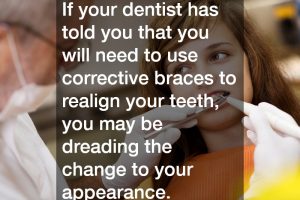
If dentists or orthodontists have told you that you will need to use corrective braces to realign your teeth, you may be dreading the change to your appearance. However, if your teeth are misaligned, getting braces can also eliminate chewing problems and speech impairments. Your use of braces will begin with a referral to an orthodontist, who will take a mold of your teeth and send it to the lab, for the braces to be made.

If you are very concerned about the change to your appearance because of braces, you may be a candidate for “invisible braces.” These are clear plastic orthodontic trays that fit onto your teeth in successively smaller sizes. Because they are clear, their appearance is much less intrusive. Many clients also like them because they can be removed for meals.

According to Invisalign, this advance in new teeth braces technology was first used in 1997. The purpose of clear braces is to give you generally straighter teeth. The aligners clip over your teeth with tabs, and the gradually smaller trays will realign your teeth. Users enjoy the freedom of removing them to clean them.
For many kids and adolescents, braces are a part of life for awhile. However, braces have come a long way. Back in the day braces were bulky and uncomfortable. Oftentimes they were even accompanied by unsightly headgear that made simple tasks like eating and enjoying life difficult. Orthodontics has changed. Nowadays, patients are offered an array of different types of braces, depending on their needs. From clear braces, invisible braces, and invisalign, the options for braces for kids are numerous.
Braces have been around for awhile. In fact, the earliest braces were designed back in 1728 and were nothing more than a flat piece of metal connected by thread to the teeth. It wasn’t until 1915 that orthodontic brackets were invented and used for the first time, and it was NASA that eventually made the metal used in modern braces.
For patients who are told by a pediatric orthodontist or regular orthodontist that they have to wear braces, though, what should they expect? If a young patient is involved in sports or other extracurricular activities, will braces interfere? How long does the average patient have to wear braces? For starters, most children and adolescents will have no problem continuing their sports or other activities with braces. Depending on the sport, a braces wearer may want to wear a protective mouth guard to protect their braces. If a wearer plays an instrument, the adjustment may prove more complicated. While certain instruments are easy to adjust to with braces, such as the saxophone and clarinet, other instruments like brass instruments are more difficult to adjust to. Why? Well, brass instruments require the musician to press their lips between a metal mouthpiece and their teeth. Trumpets and French horns are often the most difficult get used to after getting braces. Some types of braces, like invisalign, may offer a short adjustment period, though.
As for how long a patient has to wear braces? Well, that all depends on how much work the teeth need. Some patients may only need to removable invisalign braces for a few hours a day while others may need traditional metal braces for up to two years or longer. It all depends on the patient. And the work isn’t done when the braces are removed. Oftentimes patients are given a retainer to wear when their braces are removed. The retainer is important because it helps keep the newly straightened teeth from shifting out of place. It’s estimated that upwards of 25 percent of patients actually have to endure braces a second or even third time due to failure to wear their retainers on a regular basis.
Are you thinking about getting braces? Contact your local orthodontist today.